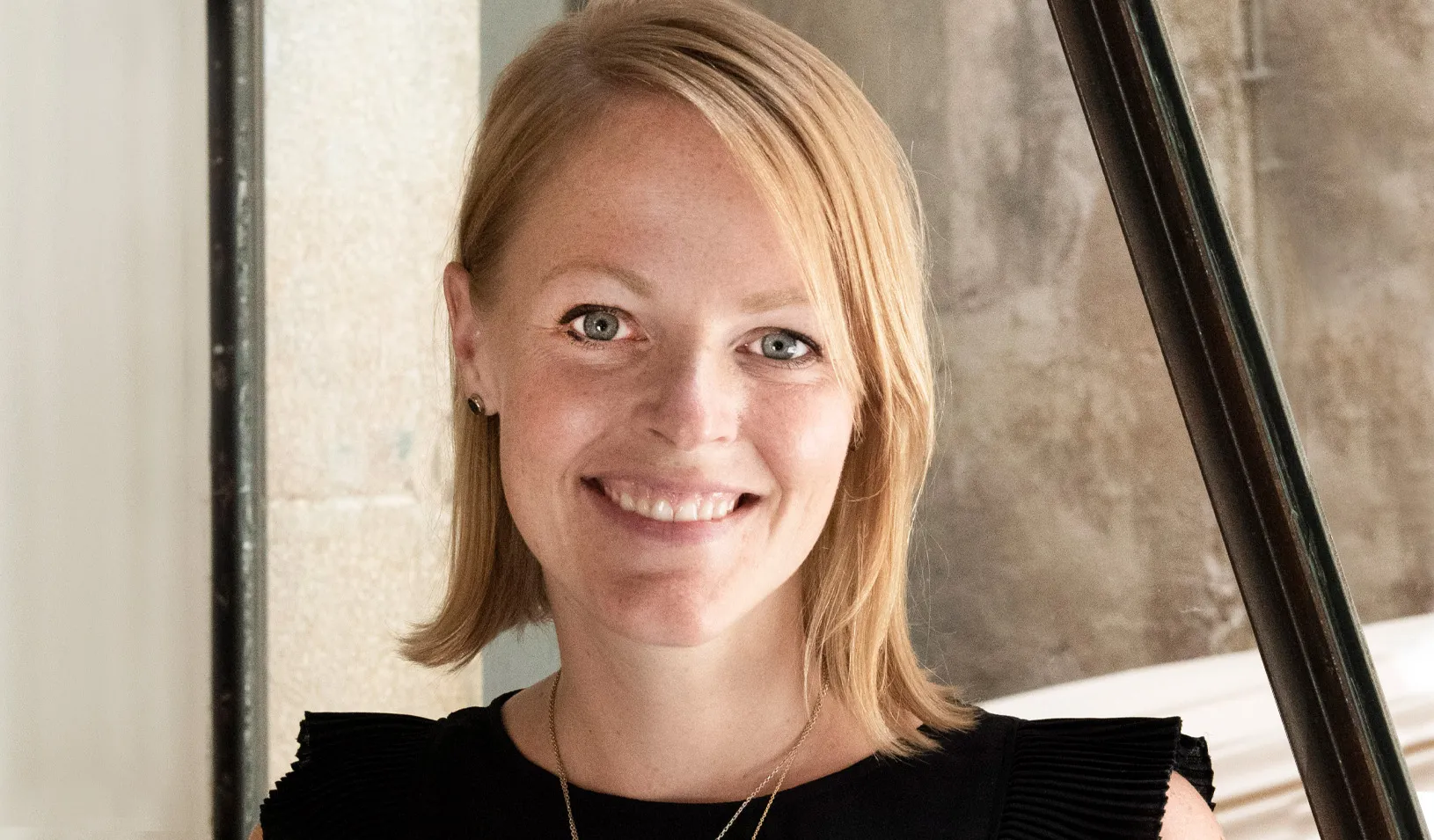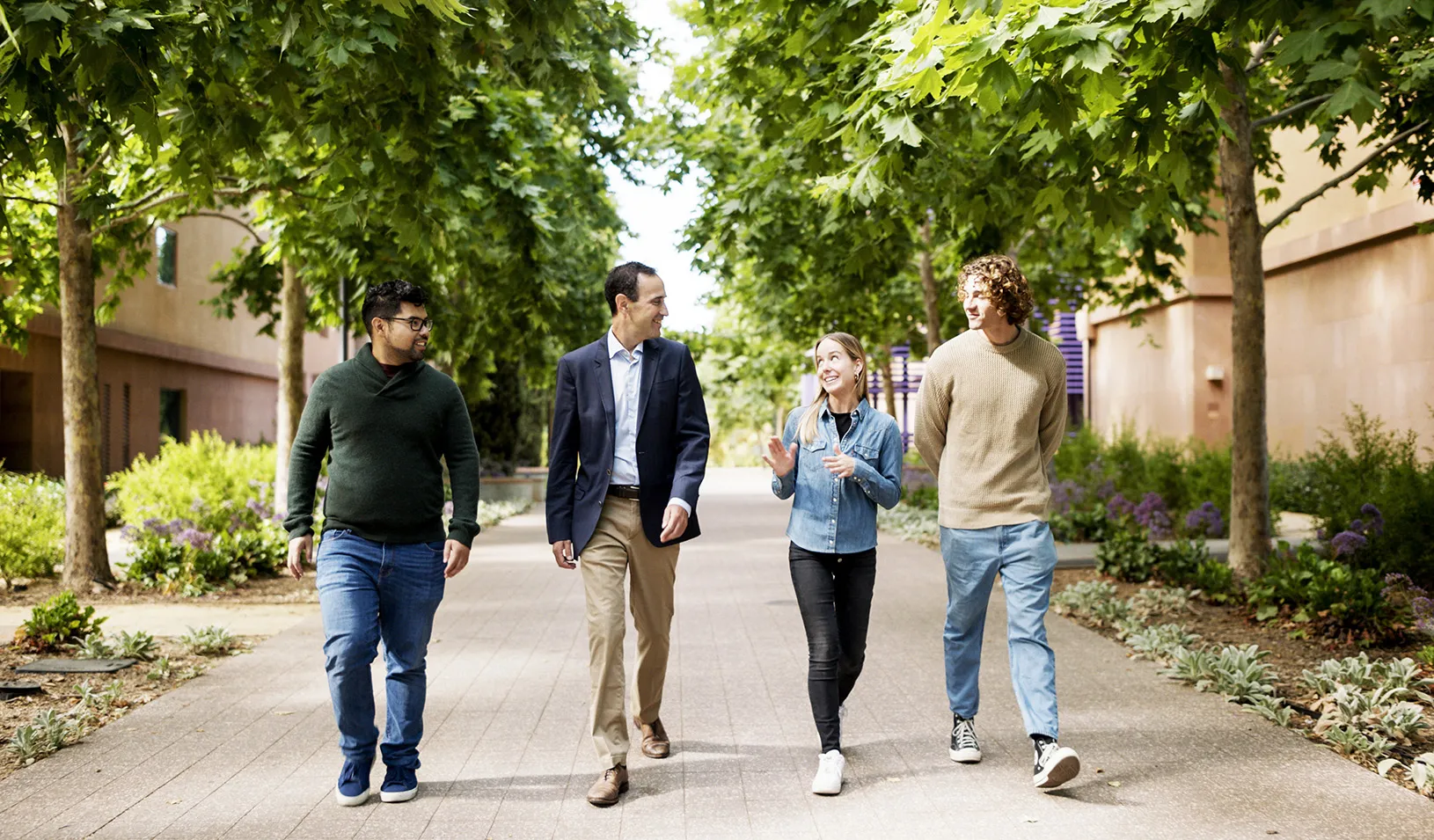An Unlikely Collaboration Prepares Leaders in the Business of Education
Joint master’s degree program expands the scope of educators’ training.
May 26, 2022

Photo by Farrin Abbott / Stanford News
Lynn Liao had always been drawn to a career in public service, but when she graduated from college, she wasn’t quite sure where to focus. So she did what countless new grads do: She took a job in management consulting.
That’s when she met Julien Phillips, MBA ’70, an entrepreneur and longtime partner at the firm where she worked. A Stanford undergrad and business school alum, Phillips had recently co-founded a nonprofit to support educators in low-performing U.S. public schools.
Liao, MA Ed/MBA ’00, had never had a particular interest in working in education, but suddenly she saw a place for herself in the field. Intrigued by the possibility of helping school districts become more effective organizations, she decided to go back to grad school, searching for a program that would combine leadership and organizational studies with a focus on the education sector. But “it was hard to find that particular combination in a single program,” said Liao.
She finally found it at Stanford, where — through an innovative collaboration between Stanford Graduate School of Business and the Graduate School of Education — she was able to earn both her MBA and a master’s in education. Now chief of staff at Rocketship Public Schools, a nonprofit network of elementary charter schools in low-income communities, Liao also found peers and mentors as she began a career in educational leadership.

Michael Kirst (middle) launched the Stanford GSE’s MA/MBA program in 1969. Here, he welcomes new students in 2021. | Steve Castillo
It’s been more than 50 years since Stanford’s education and business schools first came together to establish a joint master’s degree, one that takes no longer than the usual two-year MBA program but grants both an MA and an MBA. The program — which has students taking a full course load at both Stanford GSB and Stanford GSE, plus a summer internship or other independent study — has evolved over the decades as both fields have transformed.
“The story of this program is really one of persistence and change,” said Michael Kirst, a professor emeritus at Stanford GSE and former professor (by courtesy) at Stanford GSB, who oversaw the launch of the program in 1969 and went on to direct it for more than 30 years. “It took a lot of will on the part of the two schools to make it happen in the first place — and to make changes as the field morphed, and as students’ interests evolved. And it’s still flourishing.”
“Not a Lot of Affinity”
Launching the program in 1969 required a collaboration of a sort that’s exceedingly rare to this day, Kirst said.
“There’s typically not a lot of affinity and interaction between education and business schools,” he said. “Ed schools often have reservations about business and its profit-making motives, and business schools have reservations about the quality of education schools. There haven’t traditionally been very close ties between the two, and generally that’s still the case.”
Kirst has had a long and distinguished career in education policy: Since 1975 he’s served four terms as president of the California Board of Education, making him the longest-serving appointee in the history of that role. He also co-founded Policy Analysis for California Education, a nonpartisan research center housed at Stanford, in 1982.
When he was starting his career, Kirst never imagined that he’d find himself at Stanford, launching a graduate program or anything else. He’d headed straight to Washington, D.C., after earning his doctorate in 1964, with every intention of leaving academia behind.
In D.C. he held a series of positions in federal policymaking, including roles at the U.S. Department of Education and a U.S. Senate subcommittee – until his boss, Senator Joseph S. Clark of Pennsylvania, was defeated in the 1968 election.
“I was 29,” said Kirst, “I had a wife and two kids, and I had two weeks to clean out my desk.” He was recruited by Henry Thomas James, then dean of the GSE, to join the school’s faculty as an assistant professor. “So I moved to California — temporarily, I hoped,” said Kirst. “I thought, I’ll just come here and wait it out until things change in D.C.”
His arrival at Stanford coincided with the appointment of a new dean at Stanford GSB: Arjay Miller, who’d left his post as president of Ford Motor Company to head up the business school. Miller’s experience during the Detroit riots shaped his vision for management education, and one of his first ambitions as dean was to launch a public management program at Stanford GSB, aiming to balance corporate interests with social responsibility and better prepare students for civic leadership.
For Stanford GSB, a stronger connection with the education school “fit into where they were going,” said Kirst. “And building a program with the business school really expanded what we were able to provide on our own.”
Combining Business Acumen with Education’s Technical Core
With both schools on board, the joint degree program launched in 1969, and Kirst secured funding from the U.S. Department of Education and the Ford Foundation to provide full scholarships for applicants who enrolled. Initially a master’s in educational administration (MEA), the program was designed mainly to prepare high-level administrators at large urban school systems and universities. But it was soon changed to an MA Education/MBA, a more recognizable set of credentials that became increasingly attractive as business opportunities in the education sector swelled.
Charter schools, foundations, venture capital firms, educational startups — “all of a sudden, the market really opened up,” said Kirst. “If [employers] could get someone with an MBA and an MA in education, that was gold.” Through the program, aspiring leaders in the education space could develop both business acumen and a firm grasp of the components of teaching and learning, the technical core of education.
A graduate of the program, Van Ton-Quinlivan, MA Ed/MBA ’95, was appointed vice chancellor of workforce and economic development at California Community Colleges by Governor Jerry Brown in 2011 and now serves as CEO of Futuro Health, a nonprofit education initiative training the next generation of health care workers.
“The business and education worlds are distinct but interconnected, and living in both allowed me to see there are solutions that aren’t unique to either sector,” she said. “If you’re going to be working to reshape education, you need to be able to bridge these two worlds.”
Culture Clash
The convergence of students from two schools with somewhat dissimilar cultures often sparked provocative classroom discussions, said Kirst.
“It’s no secret that ed schools are typically left of center, and business schools are generally not,” he said. “The business classes got more of a left-wing flavor from our students.”
To Kim Jacobson, MA Ed/MBA ’99, the contrast reflected more of a bias than an ideology. “Coming from the educator side of things, you definitely had students who didn’t trust the business-minded people,” said Jacobson, who worked as an elementary school teacher in Compton, California, before enrolling in the program. She now leads strategy, marketing and business development for firms working in education. “On the business school side, [going into education] felt more like a novelty — either a passion that people appreciated, or a risky business decision.”
Despite any philosophical differences, students sought out further ways to connect over their interests. They founded a club called Partnerships for Education in the 1990s, organizing guest speakers, a research conference and other joint activities — a club that’s still going strong today. (Renamed the GSB Education Club in 2006, it is led jointly by students from both schools.) “It was a real bottom-up movement, such an impressive and vibrant group,” Kirst recalled. “I was really taken by how much energy they had.”
More Joint Ventures
Some 20 years ago, seeing the value of uniting the two disciplines on campus, the Spencer Foundation, a major funder of education research, set out to establish joint professorships in business and education at several prominent universities. But few applied, Kirst said.
“One thing I’ve always experienced at Stanford is a culture of collaboration among different schools and departments,” said GSE Professor Deborah Stipek, who joined the GSE as dean in 2001 and served until 2014. “I think that’s one of the reasons why Stanford could do this, where not many other universities would — even if they tried, and most didn’t try.”
Still, approving the candidate “was really tricky,” Stipek said. “It took some time for the two schools to agree on the person who could hold that chair.” The first to meet with both schools’ approval was Anthony Bryk, who held it until 2008, when he left Stanford to become president of the Carnegie Foundation for the Advancement of Teaching. The chair now belongs to Geoffrey Cohen, the James G. March Professorship of Organizational Studies in Education and Business.
The two schools have since partnered on other programs, including Stanford EdLEADers, a professional certificate program for K–12 district administrators, and the Stanford Educational Leaders Initiative, which focuses on professional development programming for community college leaders. The GSE has also developed a number of initiatives to build stronger connections between its education scholars and industry, including an industry affiliates program and the Entrepreneur-in-Residence program, which brings an entrepreneurial leader to campus for a year at a time to mentor the GSE community on social impact and business strategy.
The joint MA Education and MBA degree — informally dubbed “mamba” — was the first of three joint degrees now offered at the GSE. Today education master’s candidates can also concurrently earn a JD from Stanford Law School or a master’s in public policy (MPP) from the School of Humanities and Sciences. Stanford GSB, too, offers a JD/MBA and an MPP/MBA, as well as joint degrees with computer science, electrical engineering, and environment and resources. The MA Education/MBA is the GSE’s largest joint degree program, with some 20 students on average enrolling each year.
Some have already worked directly in education when they enroll, but many, like Lynn Liao, come with other backgrounds, said Geoffrey Cox, director of the MA/MBA program at the GSE. “Some have done consulting. Many come from families where maybe a parent was an educator, and they grew up with a passion about it,” he said. “They have a strong commitment to improve education, and they see market-oriented approaches as being part of the mix.”
A version of this article was first published on May 16, 2022, by the Stanford Graduate School of Education.
For media inquiries, visit the Newsroom.
Explore More
Erin Nixon Joins Stanford GSB as Assistant Dean of Admissions

Nia Rose Froome, MBA ’23: Making Local, Fresh Food Available for All

New Research Fund Promotes Responsible Leadership for the Next Century
